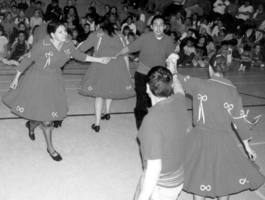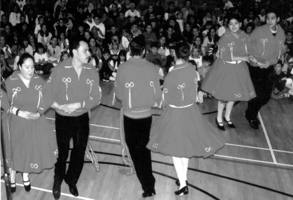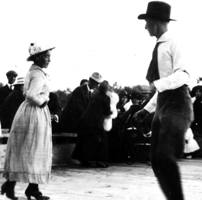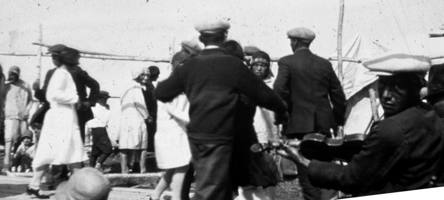
|
Folk Dance Federation of California, South, Inc.
|

|
CLICK AN IMAGE TO ENLARGE
Introduction
In Canada and the northern United States, especially in the prairies and in the Red River valley in Manitoba, there is a cultural group known as Métis, meaning people of mixed native and European ancestry. The population grew out of intermarriage between European fur traders and native North Americans. Originally "Métis" referred to French speakers while "half-breed" was used for English speaking people of mixed ancestry. Métis is now usually used to include all of those with a mixed native-European ancestry and who identify with the Métis culture.
Duck Dance (see photo above - Edmonton Métis Cultural Dance Society) Like the people themselves, Métis music and dance grew out of the social context of the fur trade. Music and dance provided welcome relief for the hard-working voyageurs of the fur trade as in the following description from the 1800's: "there was generally a fiddle or two in the crowd and lots of men who could play it . . . in one instance there was a boat's crew, where the fiddle was passed down from the steersman to the bowsman and every man in the boat could play it. It was said on these trips when a flat stone was found, it was at once utilized as a ball-room floor, and each man ‘hoed it down' to the enlivening strains of the fiddle." (MacBeth, 1893, in Bruner et al., 2002, p. 8)
Derivations
Métis music and dances owe much to French-Canadian and Scottish traditions and also have interacted with American traditions. Familiar tunes from these traditions appear in the Métis repertoire, such as Lord MacDonald Reel, Big John McNeil, Hanged Man's Reel, Haste to the Wedding, Whiskey Before Breakfast, and Crooked Stovepipe. Still, Lederman (1988) argues that there is a unique element in Métis fiddle tunes that derives from older native singing traditions.
The most obvious difference from European antecedents is that phrases are often irregular in length, or an extra musical phrase or tag is added at the end of what would be a standard 8 bar phrase. Métis dancing also differs slightly from Scottish and French Canadian traditions. Most of the dances are set dances, done to 4/4 reels. The dance figures resemble Scottish and French-Canadian dances, e.g., grand chain, arching and ducking, right and left hand stars, reels or figure eights, back to back, swings, etc. But throughout the dances, a unique jigging step is used. Where Scottish and French-Canadian dances would often use a traveling step (step-together-step-lift), Métis dancers use a jig step (for example, hop-brush-step-brush-hop-touch) both when dancing in place and when traveling. Métis dancing is also looser than Scottish or French-Canadian dancing, and individuals use their own particular variations or styles of jigging.
Structure
 The structure of the dances is also looser. The "extra" phrases of music mean that figures do not all occur in multiples of four and eight bars. Dances may be called or follow a pre-set sequence, but in either case there may be a bar or two at the end of a sequence when the dancers dance in place. Some figures may use six bars rather than four, and this seems to be somewhat arbitrary. To illustrate, a guitar player I know, who is used to accompanying Irish and other styles of music was hired to play with a fiddler for a Métis square dance competition. He was having trouble following the abrupt changes in the tunes even though he was watching the fiddler intently. Finally the fiddler said to him, "Don't watch me, watch the dancers!"
The structure of the dances is also looser. The "extra" phrases of music mean that figures do not all occur in multiples of four and eight bars. Dances may be called or follow a pre-set sequence, but in either case there may be a bar or two at the end of a sequence when the dancers dance in place. Some figures may use six bars rather than four, and this seems to be somewhat arbitrary. To illustrate, a guitar player I know, who is used to accompanying Irish and other styles of music was hired to play with a fiddler for a Métis square dance competition. He was having trouble following the abrupt changes in the tunes even though he was watching the fiddler intently. Finally the fiddler said to him, "Don't watch me, watch the dancers!"
Set dances can also be quite long, involving, for example, couple number 1 visiting each couple and doing a figure with each of them. This sequence is then repeated by couples 2, 3, and 4 in the square.
These dances bring to mind the socializing of long winter evenings or weddings that last for days, as in this description of the early Red River settlement:
In Red River, a party and dance would be held the night before the wedding, the night of the wedding, and the night when the couple went to live with the groom's parents. The hosts of the dances, generally relatives, would clear their houses of furniture to provide the maximum amount of dancing space. People playing fiddles, accordions and spoons would accompany the dancers while a caller would direct square dancers through intricate steps, to the amusement of all. Anybody who could play an instrument was invited or allowed to join in the music making. (Bruner et al., 2002, p. 17)
Another description, from Laramie, Wyoming, shows the Métis tradition mixing with others:
The winter of 1865 and ‘66 when all the mixed-blood families camped at Laramie, it was not always gloomy... The soldiers would all chip in and get up a dance. There were many fiddlers among the half-breeds and soldiers. There were quite a number of half-breed girls, all dressed up in bright calico with ribbons in their hair and on their waists, that could fly around in a quadrille as well as anybody, stepping to the music in their moccasined feet... Sometimes the emigrant women and men would join in, play the music and dance. I have heard many different calls from all the different states; they all had different calls for the same dances. It was the only sport that the old-timers enjoyed. Many times some of the older men were called out to the centre to step off a jig to fast music and they sure could do it to perfection. (Bordeaux-Bettelyoun, in Bruner et al., 2002, p.17)
Repertoire
In addition to set dances there is the famous Red River Jig that refers to both a fiddle tune and the dance done to it. The fiddle tune is made up of two simple, repetitive tunes around two different tonic notes, improvised and played a little differently each time. The dance is also improvised, a jig or step dance where individual dancers take turns showing off their steps. Unlike in the Scottish and French-Canadian traditions, the dancers use their whole bodies at times, with elbows flailing and the whole body listing to one side. (Think of Grandpa McCoy on the Beverly Hillbillies.)
Traditional dances include Drops of Brandy, Duck Dance, Waltz Quadrille, Rabbit Dance, Handkerchief Dance, Saskatchewan Circle, Sash Dance, and Reel of Eight. A few Métis dance videos have been produced, including Traditional Dances of the Métis from the Manitoba Métis Resource Centre and Step in Time from the Edmonton Métis Cultural Dance Society. (See contact information below.) I prepared the description of Reel of Eight, below, from the Manitoba video.
These Métis dances also are common on Indian reserves in Canada, at least in northern Ontario and the Prairie Provinces. In Winnipeg, you can sometimes catch square dance competitions on TV that occur in rural communities or reserves around the province. The dancers typically wear colourful matching outfits with a western look, sashes and ribbon shirts for the men and full skirts for the women, twirled as partners meet and swing. The competitions have categories for children as well as senior dancers, but the most energetic are the teenaged groups who have the stamina for these high-energy dances.
Reel of Eight
(from the Métis)
 Formation: 4 couples in a square. Couple 1 have their backs to the music, couple 2 to their right, couple 4 to their left, and couple 3 opposite. Couples 1 and 3 are "heads" the others are "sides."
Formation: 4 couples in a square. Couple 1 have their backs to the music, couple 2 to their right, couple 4 to their left, and couple 3 opposite. Couples 1 and 3 are "heads" the others are "sides."
W4 M4
M1 W3
(music)
W1 M3
M2 W2
Steps: Use a basic traveling step or a jigging step throughout, in place or while traveling or turning. Note that in either version there is a hop on count 4 leading to a first step on count 1. Traveling step: Step R forward (count 1), step L next to R (2), step R forward (3), hop on R while bringing L forward with a bit of a kick (4). Repeat with opposite footwork.
Jigging step (one variation): Hop L (count 4), brush or touch R forward (&), step on R (1), brush L forward and hold (& 2), hop on R (&), touch L and hold (3 &). (Repeat with opposite footwork.) Note: The following notes usually indicate four bars for each figure, but on the videotape the dancers often take approximately six bars. Figures need not finish with the end of a phrase of music. The weaving figure towards the end represents the weaving of the Métis sash.
Music: Reels (e.g., Whiskey Before Breakfast)
Bars (approximate)
1. Change places, Stars, and Circles
4 Heads change places (heads advance, the whole formation rotates clockwise, heads back out into opposite places)
4 Sides change places
4 Heads change places
4 Sides change places
4 Women right hand star
4 Women left hand star
4 Men right hand star
4 Men left hand star
4 Women circle left
4 Women circle right
2. Baskets
4 Men, standing behind the women, reach their arms in front of the women and join hands, forming a double circle. All circle left
4 All circle right (same formation)
4 Men lift arms over and behind women and all circle left
4 All circle right (same formation)
3. Circle
8 All join hands in a single circle and circle left
8 All circle right (same formation)
4. Grand Right and Left
16 Grand right & left (no hands), pass partner once and keep going (two bars to pass each person)
5. Weaving the Sash
4 Meet partner the second time and begin the weaving figure by doing a complete right hand turn with your partner and moving on to the next person around the circle
12 Repeat this turning figure alternating left and right hand turns with each person around the circle (4 bars to turn each person)
16 Meet your partner and repeat the weaving figure (four more turning figures)
6. Promenade
8 Meet partner and promenade counterclockwise around circle until the end of the music.
Sources
-
 Bordeaux-Bettelyoun Susan; Waggoner, Josephine (1998). With My Own Eyes: A Lakota Woman Tells Her People's History. University of Nebraska Press.
Bordeaux-Bettelyoun Susan; Waggoner, Josephine (1998). With My Own Eyes: A Lakota Woman Tells Her People's History. University of Nebraska Press. - Bruner, Trent; Kaplin, David; Dorion-Paquin, Leah (2002). Drops of Brandy: An Anthology of Métis Fiddle Music (Book and CDs). Saskatoon, Saskatchewan: Gabriel Dumont Institute.
- Edmonton Métis Cultural Dance Society, Edmonton, Alberta.
- Gabriel Dumont Institute, Lower Level Saskatoon, Saskatchewan.
- Lederman, Anne (1988). "Old Indian and Métis Fiddling in Manitoba: Origins, Structure and Question of Syncretism," Canadian Journal of Native Studies, 8:2 (1988), 205-230.
- MacBeth, John (1893). Social Customs and Amusements of the Early Days in the Red River Settlement and Rupert's Land: a paper read before the Society on January 24th, 1893. Winnipeg: Manitoba Free Press.
- Métis Resource Centre, Winnipeg, Manitoba.
Photograph Acknowledgements
- Métis Duck Dance 01 – Edmonton Métis Cultural Dance Society.
- Métis Duck Dance 02 – Edmonton Métis Cultural Dance Society.
- Métis Right Hand Star, Reel of Eight – Edmonton Métis Cultural Dance Society.
- Métis and First Nations community celebrate with fiddling and square dancing after Roman Catholic confirmation at Camperville, Manitoba – Western Canada Pictorial Index.
- Métis - Isabel Slater and Henry Daymover dancing a Red River jig at the peace celebrations at Onion Lake, Saskatchewan in 1919 – Saskatchewan Archives Board.
Printed in Folk Dance Problem Solver, 2001.
